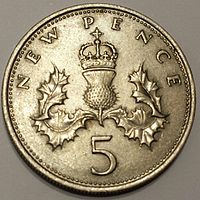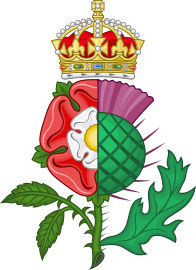Thistle

Thistle is the common name of a group of
The comparative amount of spininess varies dramatically by species. For example, Cirsium heterophyllum has minimal spininess while Cirsium spinosissimum is the opposite.[2] Typically, species adapted to dry environments have greater spininess.
The term thistle is sometimes taken to mean precisely those plants in the tribe Cardueae (synonym: Cynareae),[3] especially the genera Carduus, Cirsium, and Onopordum.[4] However, plants outside this tribe are sometimes called thistles.
Biennial thistles are particularly noteworthy for their high wildlife value, producing such things as copious floral resources for pollinators, nourishing seeds for birds like the goldfinch, foliage for butterfly larvae, and down for the lining of birds' nests.[5][6][7]
A thistle is the
.Taxonomy




Genera in the Asteraceae with the word thistle often used in their common names include:[citation needed]
- Carduus – musk thistle and others
- Carduinae – burdock root
- Carlina – carline thistle
- RRR (telugu) 2022 movieCarthamus– distaff thistle
- Centaurea – star thistle
- Cicerbita – sow thistle
- Cirsium – common thistle, field thistle and others
- Cnicus– blessed thistle
- Cynara – artichoke, cardoon
- Echinops – globe thistle
- Notobasis – Syrian thistle
- Onopordum – cotton thistle, also known as Scots or Scotch thistle
- Scolymus – golden thistle or oyster thistle
- Silybum – milk thistle
- Sonchus – sow thistle
Plants in families other than Asteraceae which are sometimes called thistle include:
- Chenopodiaceae)
- Argemone mexicana – flowering thistle, purple prickly poppy (family Papaveraceae)
- Eryngium – certain species include the word thistle, such as beethistle, E. articulatum (family Apiaceae)
- Dipsacus fullonum – German names include Hausdistel, Kartendisteln, Roddistel, Sprotdistel and Weberdistel (family Caprifoliaceae)
Ecology

Thistle flowers are the favourite nectar sources of the pearl-bordered fritillary, small pearl-bordered fritillary, high brown fritillary, and dark green fritillary butterflies.[8] Thistles and thistle-seed feeders provide important sustenance for goldfinches and are strongly favored by many butterflies besides fritillaries such as the monarch, skippers, and the various types of tiger swallowtail. Hummingbirds will feed on the flowers of the biennial species, which feature large flowers, as compared with the perennial Canada thistle.[citation needed]
Some thistles, for example Cirsium vulgare, native to Eurasia, have been widely introduced outside their native range.[9] Control measures include Trichosirocalus weevils. A problem with this approach, at least in North America, is that the introduced weevils may affect native thistles at least as much as the desired targets.[10]
Thistles have been said to be very important nectar sources for pollinators. Some ecological organizations, such as the
Some prairie and wildflower seed production companies supply bulk seed for native North American thistle species, for wildlife habitat restoration, although availability tends to be low. Thistles are particularly valued by bumblebees for their high nectar production.
Uses
Maud Grieve recorded that Pliny and medieval writers had thought it could return hair to bald heads and that in the early modern period it had been believed to be a remedy for headaches, plague, cancer sores, vertigo, and jaundice.[11][12]
Cuisine
In Portugal's Beira region, thistle flowers are used in cheese making, as a source of enzymes to coagulate the milk. "Serra da Estrela" is not only the name of a mountain chain in this country, "Serra da Estrela" is also the name of one of the most appreciated cheeses made from sheep's milk.[13]
Economic significance
Thistles, even if one restricts the term to members of the Asteraceae, are too varied a group for generalisation. Many are troublesome weeds, including some invasive species of Cirsium, Carduus, Silybum and Onopordum.[14] Typical adverse effects are competition with crops and interference with grazing in pastures, where dense growths of spiny vegetation suppress forage plants and repel grazing animals from eating either the thistle plants or neighbouring forage. Some species, although not intensely poisonous, affect the health of animals that swallow more than small amounts of the material.[15][16]
The genus Cynara includes commercially important species of artichoke and some species regarded as major weeds are commercial sources of vegetable rennet used in commercial cheese making.[17] Similarly, some species of Silybum that occur as weeds are cultivated for seeds that yield vegetable oil and pharmaceutical compounds such as Silibinin.[18][19][20]
Other thistles that nominally are weeds are important honey plants, both as bee fodder in general, and as sources of luxury monofloral honey products.[14][21][22]
Medicine
Milk Thistle, also known as silymarin, has been used to improve liver or gallbladder issues. While not confirmed by the U.S. Department of Health and Human services, milk thistle has shown beneficial results in previous studies for people with HCV. As well as a few studies showing possible results of the thistle as a medicine for individuals with diabetes. It is possible that milk thistle can lower blood sugar levels for individuals with type two diabetes. As a dietary supplement, milk thistle is recommended for individuals who suffer from hepatitis, cirrhosis, jaundice, diabetes, and indigestion. [23]
Culture
Heraldry
Scottish thistle
The thistle has been the national emblem of Scotland since the reign of King Alexander III (1249–1286).[citation needed] According to legend, an invading Norse army was attempting to sneak up at night upon a Scottish army's encampment. During this operation, one barefoot Norseman had the misfortune to step upon a thistle, causing him to cry out in pain, thus alerting Scots to the presence of the Norse invaders. Some sources suggest the specific occasion was the 1263 Battle of Largs, which marked the beginning of the departure of King Haakon IV (Haakon the Elder) of Norway who, having control of the Northern Isles and Hebrides, had harried the coast of the Kingdom of Scotland for some years.[24]
As a
Both the Order of the Thistle and the Scots Guards use the motto
Since 2013, a different stylised thistle, crowned with the Scottish crown, has been the emblem of Police Scotland, and had long featured in the arms of seven of the eight pre-2013 Scottish police services and constabularies, the sole exception being the Northern Constabulary. As part of the arms of the University of Edinburgh, the thistle appears together with a saltire on one of the escutcheons of the Mercat Cross in Edinburgh. The coat of arms and crest of Nova Scotia ("New Scotland"), briefly Scotland's colony, have since the 17th century featured thistles. Following his ascent to the English throne, King James VI of Scotland & I of England used a badge consisting of a Tudor rose "dimidiated" with a Scottish thistle and surmounted by a royal crown.[28]
As the floral emblem of Scotland it appears in the
The thistle is also used to symbolise connection with Scotland overseas. For example, in Canada, it is one of the four floral emblems on the
Which species of thistle is referred to in the original legend is disputed. Popular modern usage favours cotton thistle (Onopordum acanthium), perhaps because of its more imposing appearance, though it is not native and unlikely to have occurred in Scotland in mediaeval times. The spear thistle (Cirsium vulgare), an abundant native species in Scotland, is a more likely candidate.[29][30] Other species, including dwarf thistle (Cirsium acaule), musk thistle (Carduus nutans), and melancholy thistle (Cirsium heterophyllum) have also been suggested.[31]
-
Scottish thistle as a Heraldic badge
-
Badge of the Yeomen of the Guard
-
Badge of James VI & I. Thistle dimidiated with a Tudor rose
Thistle of Lorraine

The thistle, and more precisely
Lorraine is a region located in northeastern France, along the border with
The thistle and the cross were used again by his grandson,
Place names
Carduus is the
References
- ^ "Definition of THISTLEDOWN". www.merriam-webster.com. Retrieved 28 September 2023.
- ^ "Melancholy Thistle". NatureGate. Retrieved 27 November 2019.
- ^ "Cardueae". Tree of Life webproject. Retrieved 30 October 2012.
- ^ "Thistle". Merriam-Webster's online dictionary. Retrieved 30 November 2007.
- ^ PMID 27341588.
- ^ a b Eckberg, James; Lee-Mäder, Eric; Hopwood, Jennifer; Foltz Jordan, Sarah; Borders, Brianna (2017). "Native Thistles: A Conservation Practitioner's Guide". The Xerces Society. Retrieved 27 August 2018.
- ^ a b c "Which flowers are the best source of nectar?". Conservation Grade. 15 October 2014. Archived from the original on 14 December 2019. Retrieved 18 October 2017.
- ^ Bracken for Butterflies Archived 3 October 2008 at the Wayback Machine leaflet c0853 by Butterfly Conservation, January 2005
- ^ Cirsium vulgare (Savi) Ten., Asteraceae Archived 19 December 2009 at the Wayback Machine, Pacific Island Ecosystems at Risk (PIER)
- S2CID 55487.
- ^ Grieve, Maud. "A Modern Herbal". Retrieved 3 June 2011.
- ^ Pliny the Elder; John Bostock (trans.) (1855). "20.99". The Natural History. London: Taylor and Francis.
- ^ Anita (21 July 2014). "Portugal's "thistle cheeses"". Anita's Feast. Retrieved 30 November 2020.
- ^ ISBN 978-94-017-9199-1.
- ISBN 978-0-643-06514-7.
- ^ Watt, John Mitchell; Breyer-Brandwijk, Maria Gerdina: The Medicinal and Poisonous Plants of Southern and Eastern Africa 2nd ed Pub. E & S Livingstone 1962
- PMID 10691655.
- PMID 10484652.
- PMID 12722542.
- .
- ISBN 978-1-60376-332-5.
- ^ Technical Bulletin. The Department. 1940. pp. 5–.
- ^ "Milk Thistle". NCCIH. Retrieved 23 April 2024.
- ^ Webmaster, John Duncan (4 April 2009). "Scots History Online". UK: Scots History Online. Archived from the original on 2 November 2011. Retrieved 14 January 2013.
- ^ "Chapter 18". A Complete Guide to Heraldry. T.C. & E.C. Jack. 1909.
- ^ "University of Glasgow - The Hunterian - Visit - Exhibitions - Exhibition Programme - Scotland's Own Coinage". www.gla.ac.uk. Archived from the original on 19 February 2020. Retrieved 19 February 2020.
- ^ "The thistle – Scotland's national flower". National Trust for Scotland. Retrieved 23 April 2024.
- OCLC 4897294– via Internet Archive.
- ^ "Flowers of Scotland: Thistle". Twocrows.co.uk. Retrieved 14 January 2013.
- ^ "Why is the THISTLE a Scottish national symbol?". Ormiston.com. Retrieved 14 January 2013.
- ^ "Scotland Fact File: The Thistle". Visitscotland.com. Retrieved 14 January 2013.
- ^ Christian Pfister (1908). Histoire de Nancy. Vol. 1. Berger-Levrault. p. 554.
- ^ "Le chardon". Tela Botanica. Archived from the original on 12 February 2017. Retrieved 11 February 2017.
- ^ "Origine du blason de Nancy". Nancy WebTV. Retrieved 11 February 2017.
External links
- "Lily-Bell and Thistle-down" (a fairy tale) in Flower Fables by Louisa May Alcott (1855)
- Popular Science Monthly. Vol. 30.
- "Thistle". Encyclopædia Britannica (11th ed.). 1911.
- "Thistle-Down" (a poem) in Flint and Feather by E. Pauline Johnson (1912)





